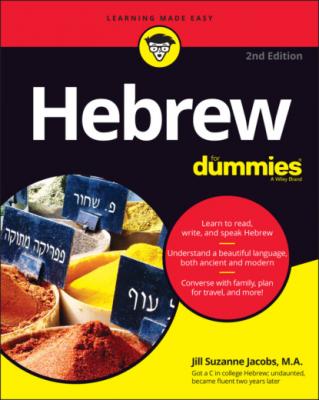Hebrew For Dummies. Jill Suzanne Jacobs
Читать онлайн.| Название | Hebrew For Dummies |
|---|---|
| Автор произведения | Jill Suzanne Jacobs |
| Жанр | Иностранные языки |
| Серия | |
| Издательство | Иностранные языки |
| Год выпуска | 0 |
| isbn | 9781119862048 |
To count by hundreds, first say the feminine number of the quantity of hundreds, such as four (אַרְבַּע), and then add the word for hundreds (מֵאוֹת). This pattern continues until a thousand:
| 100 | מֵאָה | may-ah |
| 200 | מָאתַיִם | mah-tah-yeem |
| 300 | שְׁלוֹשׁ מֵאוֹת | shlohsh-meh-oht |
To count by thousands, first you say the feminine number of the quantity of thousands and then follow it with the word for thousands, אֲלָפִי (ah-lah-feem). This pattern continues to 1 million. The Hebrew word for 1,000 is אֶלֶף (eh-lehf), and the word for 2,000 is אַלְפַּיִם (ahl-pah-yeem):
| 1,000 | אֶלֶף | eh-lehf |
| 2,000 | אַלְפַּיִם | ahl-pah-eem |
| 3,000 | שְׁלֹשֶׁת אֲלָפִים | shloh-sheht ah-lah-feem |
| 10,000 | עֲשֶׂרֶת אֲלָפִים | ah-seh-reht ah-lah-feem |
| 1,000,000 | מִלְיוֹן | meel-yohn |
Several chapters in this book give you an opportunity to practice using numbers. Check out Chapter 9 to find out how to ask for and give phone numbers. Also see Chapter 14, which is all about money. Don’t you love counting money?
Recognizing Tips to Help You Read Hebrew
Hebrew is no ordinary language. Quite the contrary. Hebrew dates back more than 3,500 years to antiquity, and the Hebrew alphabet is quite possibly the first alphabet known to humankind. Hebrew was the language of King David and King Solomon, and the Bible’s original language. Furthermore, ancient people called the Phoenicians based their alphabet on the Hebrew alphabet. The Greeks based their alphabet on the Phoenicians’ letters. And the Latin letters you’re reading right now are derived from the Greeks’ letters! So, although the Hebrew language may look a little different, only four degrees separate it from what you’re used to.
Figuring out the Hebrew alphabet’s shapes, sounds, and stories
The Hebrew alphabet is one of the oldest alphabets still in use today. Even though the letters look different from the Latin characters that comprise the English alphabet, don’t be intimidated! Just spend some time memorizing the shapes and sounds of these Hebrew letters and reading Hebrew will be easier!
Like many ancient alphabets, the Hebrew alphabet is written from right to left. Hebrew consists of 22 letters, all of which are consonants. Vowels aren’t written within the consonant letters; rather, they’re written in the form of dots and dashes below the consonant letters. For a more complete discussion of Hebrew vowels, see “Those dots and dashes they call vowels” later in this chapter.
The pronunciation I provide in this book is the Sephardic (Mediterranean) pronunciation, which is spoken in Israel today. Ashkenazi (European) pronunciation differs slightly; the vowels, for example, have different pronunciations, and a few consonants are different as well. I use Sephardic pronunciation in this book.
Deciphering the consonant letters
Table 1-5 shows the Hebrew letters and their sounds.
TABLE 1-5 The Hebrew Alphabet
| Name of the Letter | Pronunciation | Hebrew Character | The Sound It Makes |
|---|---|---|---|
| Aleph | ah-lehf | א | Makes no sound. |
| Bet | beht | בּ | Makes a B sound as in boat. |
| Vet | veht | ב | Makes a V sound as in veterinarian. |
| Gimmel | gee-mehl | ג | Makes a G sound as in girl. |
| Dalet | dah-leht | ד | Makes a D sound as in door. |
| Hey | hey | ה | Makes a soft H sound as in hello. |
| Vav | vahv | ו | Also makes a V sound as in veterinarian. (Don’t ask me why.) |
| Zayin | zah-een | ז |
Makes a Z sound
|
